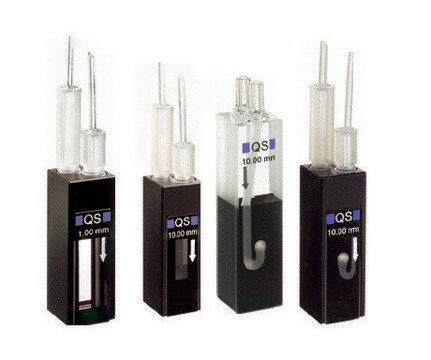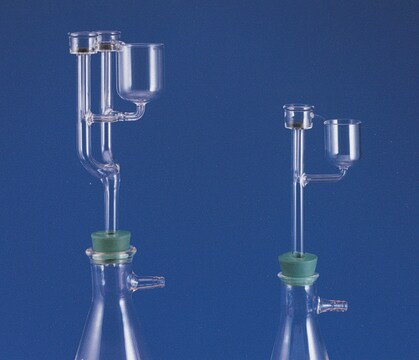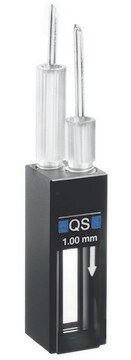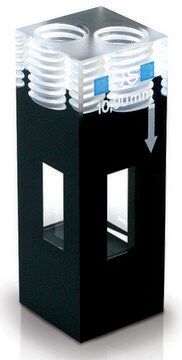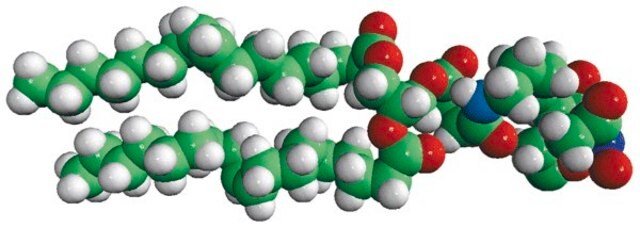Z805939
Hellmanex™ III
Special Cleaning Concentrate for cuvettes
Sinonimo/i:
III-Grade Laboratory Detergent
Autenticatiper visualizzare i prezzi riservati alla tua organizzazione & contrattuali
About This Item
Codice UNSPSC:
12000000
NACRES:
SB.32
Prodotti consigliati
Confezionamento
pkg of 1 L (PE bottle)
Produttore/marchio commerciale
Hellma
tecniche
UV/Vis spectroscopy: suitable
photometry: suitable
Descrizione generale
Hellmanex III significantly reduces the surface tension of water. The removal of dirt particles is also assured by the good wetting action of a Hellmanex III aqueous solution, while its high emulsifying and dispersing capabilities prevent the redeposition of the loosened particles. Special surface-active substances facilitate the residue-free rinsing of the optical components once they have been cleaned.
Hellmanex III is filtered to 1 μm and is therefore virtually free of solid particles.
Hellmanex III is filtered to 1 μm and is therefore virtually free of solid particles.
Applicazioni
The optimal dilution (usually 0.5 to 2 vol-%) depends on several factors, such as the hardness of the water, the degree and type of contamination, the temperature, etc. The use of demineralised water improves the cleaning characteristics.
An increase in temperature speeds up the cleaning process. However, at high temperatures it is necessary to avoid thermal shock. The cells should be pre-warmed before being submerged into hot cleaning solutions.
Hellmanex III, when diluted to its working concentration of 2%, is suitable for use with glass, quartz, sapphire, porcelain, ceramics, plastics, and ferrous metals. It can also be used, with some limitations, on metals that are sensitive to corrosion such as aluminium and other non-ferrous metals. In such cases, avoid prolonged application. In the case of materials not listed here, suitability tests should be carried out or enquiries directed to Hellma.
The concentrate can be stored in vessels made of stainless steel, PE, PP, PVC, FPM, or NBR.
An increase in temperature speeds up the cleaning process. However, at high temperatures it is necessary to avoid thermal shock. The cells should be pre-warmed before being submerged into hot cleaning solutions.
Hellmanex III, when diluted to its working concentration of 2%, is suitable for use with glass, quartz, sapphire, porcelain, ceramics, plastics, and ferrous metals. It can also be used, with some limitations, on metals that are sensitive to corrosion such as aluminium and other non-ferrous metals. In such cases, avoid prolonged application. In the case of materials not listed here, suitability tests should be carried out or enquiries directed to Hellma.
The concentrate can be stored in vessels made of stainless steel, PE, PP, PVC, FPM, or NBR.
Note legali
Hellmanex is a trademark of Hellma GmbH
Avvertenze
Danger
Indicazioni di pericolo
Consigli di prudenza
Classi di pericolo
Eye Dam. 1 - STOT SE 3
Organi bersaglio
Respiratory system
Codice della classe di stoccaggio
12 - Non Combustible Liquids
Classe di pericolosità dell'acqua (WGK)
WGK 1
Punto d’infiammabilità (°F)
Not applicable
Punto d’infiammabilità (°C)
Not applicable
Scegli una delle versioni più recenti:
Certificati d'analisi (COA)
Lot/Batch Number
It looks like we've run into a problem, but you can still download Certificates of Analysis from our Documenti section.
Se ti serve aiuto, non esitare a contattarci Servizio Clienti
Possiedi già questo prodotto?
I documenti relativi ai prodotti acquistati recentemente sono disponibili nell’Archivio dei documenti.
I clienti hanno visto anche
Stefan Niekamp et al.
The EMBO journal, 38(13), e101414-e101414 (2019-07-04)
The movement of a molecular motor protein along a cytoskeletal track requires communication between enzymatic, polymer-binding, and mechanical elements. Such communication is particularly complex and not well understood in the dynein motor, an ATPase that is comprised of a ring
Doug K Tischer et al.
eLife, 8 (2019-04-06)
T cells are thought to discriminate self from foreign peptides by converting small differences in ligand binding half-life into large changes in cell signaling. Such a kinetic proofreading model has been difficult to test directly, as existing methods of altering
Stefan Niekamp et al.
Proceedings of the National Academy of Sciences of the United States of America, 116(10), 4275-4284 (2019-02-17)
Light microscopy is a powerful tool for probing the conformations of molecular machines at the single-molecule level. Single-molecule Förster resonance energy transfer can measure intramolecular distance changes of single molecules in the range of 2 to 8 nm. However, current
Il team dei nostri ricercatori vanta grande esperienza in tutte le aree della ricerca quali Life Science, scienza dei materiali, sintesi chimica, cromatografia, discipline analitiche, ecc..
Contatta l'Assistenza Tecnica.
